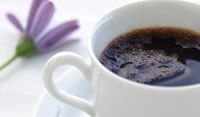First Line Treatment – Behavioral Therapy & Self-Help
Several studies have found that behavioral treatment was either equivalent to or better than the use of traditional OAB oral medications. In one study, behavioral therapy yielded a mean 80.7% reduction in incontinence episodes and was significantly more effective than oxybutynin.(1) Most studies have found a 50 to 80% reduction in incontinence episodes and reduction in frequency for men and women (2).
1. Diet Modification
 Patients with OAB are always advised to avoid caffeinated foods and beverages such as coffees, black tea, green tea, sodas and chocolate. Foods that are high in acid or alcohol may also trigger irritation in other bladder conditions (interstitial cystitis and chronic prostatitis), thus OAB patients might find it helpful to avoid vinegar, citrus drinks, concentrated tomato products, Vitamin C and multivitamins. Click here to read more about the IC Diet
Patients with OAB are always advised to avoid caffeinated foods and beverages such as coffees, black tea, green tea, sodas and chocolate. Foods that are high in acid or alcohol may also trigger irritation in other bladder conditions (interstitial cystitis and chronic prostatitis), thus OAB patients might find it helpful to avoid vinegar, citrus drinks, concentrated tomato products, Vitamin C and multivitamins. Click here to read more about the IC Diet
2. Bladder Training
Bladder training and a scheduled voiding program can help patients gain control over excessive frequency, bad voiding habits and, hopefully, some incontinence. In these cases, the urologist will provide a schedule that will help patients slowly increase their bladder capacity. It can take several weeks, perhaps up to three months, to see success. Patients must be patient and consistent! There are two retraining common retraining techniques
A. Schedule bathroom visits
Determine how often you’re going to the bathroom based by first completing a voiding diary. Then add about 15 minutes to that time. For example, if you’re going to the bathroom every thirty minutes, schedule bathroom visits at every 45 minutes. Use the bathroom at each scheduled visit, regardless of whether you actually feel the urge to go. Gradually increase the amount of time between bathroom breaks.(3)
B. Delayed urination
When you feel the urge to urinate, hold it for another five minutes or so. Then gradually increase the amount of time by 10 minutes, until you can last for at least three to four hours without having to go to the bathroom. If you’re feeling a strong need to go, try distracting yourself by counting backwards from 100 to one or practicing relaxation techniques such as deep breathing. When you just can’t hold it any longer, use the bathroom, but go again at your next scheduled void time to stay on your bladder retraining schedule.(3)
3. Pelvic Floor Physical Therapy
Because muscle strength and function is an important factor in bladder conditions and incontinence, patients may need to work with a physical therapist to strengthen their muscle tone. Learn more about physical therapy in our Pelvic Floor Dysfunction Information Center.
4. Weight Loss
Patients who struggle with morbid obesity must accept that their extra weight is putting pressure on the pelvic floor muscles that can lead to muscle and bladder dysfunction. There is good news. Studies of patients who are morbidly obese have found a reduction of incontinence episodes (47%) after just an 8% weight loss.(5) Talk with your doctor about appropriate weight loss options for your health.
We at the ICN are strong supporters of the “Hungry For Change” movement. Rather than eating foods that are pre manufactured and often heavy in sugar and carbs, we encourage patients to eat a simple, fresh healthy diet. Not convinced? Check out the wonderful video below! You can watch the whole movie for free on their website – hungryforchange.tv
References
- Ellsworth P, et al.Overactive Bladder – Etiology, Diagnosis, and Impact. Medscape CME Publication. March 25, 2011.
- Milsom I, et al. How widespread are the symptoms of an overactive bladder and how are they managed? A population-based prevalence study. BJU Int. 2001 Jun;87(9):760-6.
- Gormley, at al. Diagnosis and Treatment of Overactive Bladder (Non-Neurogenic) in Adults: AUA/SUFU Guideline. May 2012
- Bladder Training – WebMD Incontinence & overactive Bladder Health Center
- Subak LL, Wing R, West DS et al: Weight loss to treat urinary incontinence in overweight and obese women. NEJM 2009; 360: 481.
